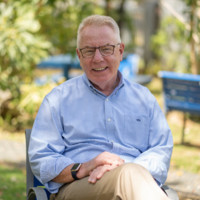
Mike Byrne talks about the events of Sept. 11, 2001 as if he’s recalling a day last week. Like many who responded that day, Mike found meaning and comfort in the work he did to help those who survived, and worked tirelessly to honor those lost.
A dentist appointment kept Byrne from going to the FEMA Region 2 office at 26 Federal Plaza in downtown Manhattan where he worked as the region’s Response Division Director. However, with other leaderships attending the annual National Emergency Management Association’s conference in Montana. Byrne was the senior official in charge of Region 2.
Just before leaving for the dentist, his phone rang.
“I didn’t have my TV on, and I got a call from Jose Bravo who ran the Caribbean office at the time,” Byrne said. “He said ‘Mike, turn on your TV.’ And I’ll never forget his voice in telling me to do that.”
After hanging up and seeing the first plane had hit the tower, Mike laughingly recalls a relative from Ireland calling and asking in a thick Irish brogue, “’Honey have you seen what’s going on down there?’ I told her I loved her, but I really needed that phone line to make some calls.”
“Even before the second plane hit, I was already in response mode because knew FEMA would provide resources,” he said. “I saw the second plane hit on TV and knew we were being attacked, but I’ll never forget those two phone calls before that second plane.”
Byrne retired from the New York Fire Department after 20 years of service just two years before these events, so he was ready to support his city and former department in his new role. “I knew enough about FEMA after two years to know what buttons to push to start moving assets,” he said.
After the second plane hit, Byrne asked his wife to pack him a bag because Regional staff would relocate to New Jersey to support the response. As he was leaving his house, his next-door neighbor Robin Freund stopped him. Her husband Pete was an amateur astronomer and a lieutenant with FDNY.
“She said ‘Pete’s working today, can you check on him?’” he said. “A couple of days later, they had the list of those who were missing and asked me if I wanted to see it. I didn’t. I didn’t want to get distracted. I needed to stay focused. Then I remembered Robin asking me to check on Pete.”
Pete Freund was listed among the missing and would later be named a victim of the attacks. Byrne remembers Pete’s love of astronomy and listening to the Grateful Dead while looking at the stars.
Byrne helped set up the alternate response location in New Jersey, when staff like Federal Coordinating Officer Ted Monette and others began arriving. It was Sept. 12 before he decided he had to go into Manhattan.
“About 3 a.m., I decided I had to go see the site,” he said. I drove through the Lincoln Tunnel and didn’t see another car all the way through. When I got to the other side, you would’ve thought it was snowing – just dust and ash all over the place… I walked to the command post and the dust was ankle deep. It was a scene I’ll never forget.”
Byrne, who knew the chief in charge at the scene, began a conversation with him about resources and was struck at what little the team was working from.
“At the time, they were using magnets on a fold out metal board – to show where companies had been operating. So, I knew the next day we had to get a more robust command vehicle to them.”
With new team members were coming on board, and Byrne knew they had to select a site for the recovery office and he provided important advice to those working this mission. “I said go down to the site, walk around and take as much time as you want, then get it out of your system.” He knew they’d need to process the event so they could focus on how the response needed to unfold.
Two months into the recovery, Byrne was selected to serve with Secretary Ridge on developing the future of the nation’s domestic response efforts, including Homeland Security Presidential Directive 5, at the newly formed Department of Homeland Security. Issued in 2003, the directive remains in effect today after establishing a single, comprehensive national incident management system that didn’t exist during the 9/11 response.
“We had to have one unified source of domestic response capabilities, that could integrate, using NIMS (the National Incident Management System), anywhere in the nation” he said. “That was the big idea. I felt like, I owned something, that I had survived it, and I needed to make as big a contribution as a possibly could. Given the opportunity I was given to work in the White House with that team to develop the nation’s strategy is a gift I hope I am worthy of.”
Byrne lost hundreds of former co-workers and his own next-door neighbor on that tragic day.
“I remember literally weeks and days on end and thinking that it was my wife at the time who had the harder job, going next door with Robin and helping with the family and kids. And that story can be told 3,000 times over of all the neighbors reaching out and helping those families. But I had to try and stay focused. I think I’m still processing the rest,” he said. “I’ve never gone to the museum. I’ve got it kinda locked up tight inside myself.”
Following his retirement from FEMA in 2018, Byrne now works as an executive for a consulting company.


